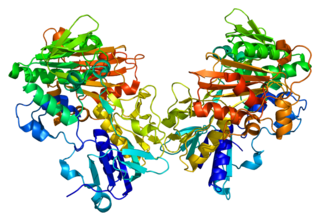GRAM domain containing 4 (GRAMD4) also known as Death-Inducing Protein (DIP) is a protein that is encoded by the GRAMD4 gene. [5] [6]
GRAM domain containing 4 (GRAMD4) also known as Death-Inducing Protein (DIP) is a protein that is encoded by the GRAMD4 gene. [5] [6]
GRAMD4 is a mitochondrial effector of E2F1 (MIM 189971)-induced apoptosis. [7]

Apoptosis regulator BAX, also known as bcl-2-like protein 4, is a protein that in humans is encoded by the BAX gene. BAX is a member of the Bcl-2 gene family. BCL2 family members form hetero- or homodimers and act as anti- or pro-apoptotic regulators that are involved in a wide variety of cellular activities. This protein forms a heterodimer with BCL2, and functions as an apoptotic activator. This protein is reported to interact with, and increase the opening of, the mitochondrial voltage-dependent anion channel (VDAC), which leads to the loss in membrane potential and the release of cytochrome c. The expression of this gene is regulated by the tumor suppressor P53 and has been shown to be involved in P53-mediated apoptosis.

The BH3 interacting-domain death agonist, or BID, gene is a pro-apoptotic member of the Bcl-2 protein family. Bcl-2 family members share one or more of the four characteristic domains of homology entitled the Bcl-2 homology (BH) domains, and can form hetero- or homodimers. Bcl-2 proteins act as anti- or pro-apoptotic regulators that are involved in a wide variety of cellular activities.

The BCL2 associated agonist of cell death (BAD) protein is a pro-apoptotic member of the Bcl-2 gene family which is involved in initiating apoptosis. BAD is a member of the BH3-only family, a subfamily of the Bcl-2 family. It does not contain a C-terminal transmembrane domain for outer mitochondrial membrane and nuclear envelope targeting, unlike most other members of the Bcl-2 family. After activation, it is able to form a heterodimer with anti-apoptotic proteins and prevent them from stopping apoptosis.

Caspase 2 also known as CASP2 is an enzyme that, in humans, is encoded by the CASP2 gene. CASP2 orthologs have been identified in nearly all mammals for which complete genome data are available. Unique orthologs are also present in birds, lizards, lissamphibians, and teleosts.

Death receptor 4 (DR4), also known as TRAIL receptor 1 (TRAILR1) and tumor necrosis factor receptor superfamily member 10A (TNFRSF10A), is a cell surface receptor of the TNF-receptor superfamily that binds TRAIL and mediates apoptosis.

Receptor-interacting serine/threonine-protein kinase 2 is an enzyme that in humans is encoded by the RIPK2 gene.

Apoptosis-inducing factor 1, mitochondrial is a protein that in humans is encoded by the AIFM1 gene on the X chromosome. This protein localizes to the mitochondria, as well as the nucleus, where it carries out nuclear fragmentation as part of caspase-independent apoptosis.

Bcl-2-interacting killer is a protein that in humans is encoded by the BIK gene.

Decoy receptor 1 (DCR1), also known as TRAIL receptor 3 (TRAILR3) and tumor necrosis factor receptor superfamily member 10C (TNFRSF10C), is a human cell surface receptor of the TNF-receptor superfamily.

Apoptosis regulatory protein Siva is a protein that in humans is encoded by the SIVA1 gene. This gene encodes a protein with an important role in the apoptotic pathway induced by the CD27 antigen, a member of the tumor necrosis factor receptor (TFNR) superfamily. The CD27 antigen cytoplasmic tail binds to the N-terminus of this protein. Two alternatively spliced transcript variants encoding distinct proteins have been described.

Nucleolar protein 3 is a protein that in humans is encoded by the NOL3 gene.

Leucine-rich repeats and death domain containing, also known as LRDD or p53-induced protein with a death domain (PIDD), is a protein which in humans is encoded by the LRDD gene.

Death effector domain containing protein is a protein that in humans is encoded by the DEDD gene.

Bok is a protein-coding gene of the Bcl-2 family that is found in many invertebrates and vertebrates. It induces apoptosis, a special type of cell death. Currently, the precise function of Bok in this process is unknown.

Mitochondrial uncoupling protein 4 is a protein that in humans is encoded by the SLC25A27 gene.

Pleckstrin homology-like domain family A member 1 (PHLDA1) is a protein that in humans is encoded by the PHLDA1 gene.

Apoptosis-inducing factor 2 (AIFM2), also known as apoptosis-inducing factor-homologous mitochondrion-associated inducer of death (AMID), is a protein that in humans is encoded by the AIFM2 gene, also known as p53-responsive gene 3 (PRG3), on chromosome 10.

Etoposide-induced protein 2.4 homolog is a protein that in humans is encoded by the EI24 gene.

NLRX1 or NLR family member X1, short for nucleotide-binding oligomerization domain, leucine rich repeat containing X1 is a protein that in humans is encoded by the NLRX1 gene. It is also known as NOD-like receptor X1, NLR family, X1, NOD5, NOD9, and CLR11.3, and is a member of the NOD-like receptor family of pattern recognition receptors.

Solute carrier family 22 member 13 is a protein that in humans is encoded by the SLC22A13 gene.
This article incorporates text from the United States National Library of Medicine, which is in the public domain.